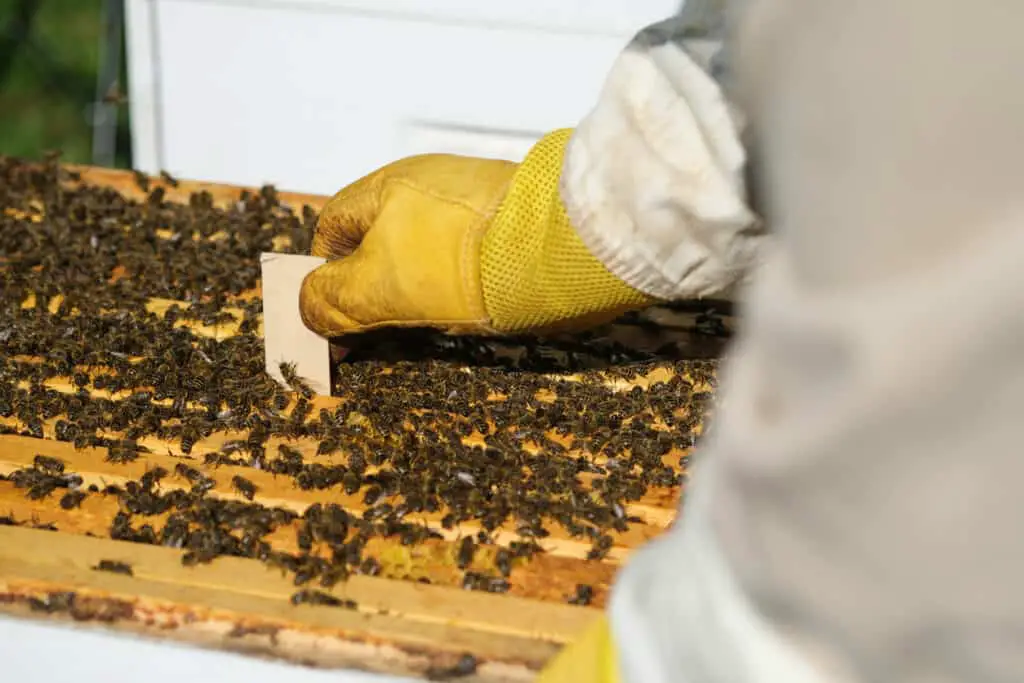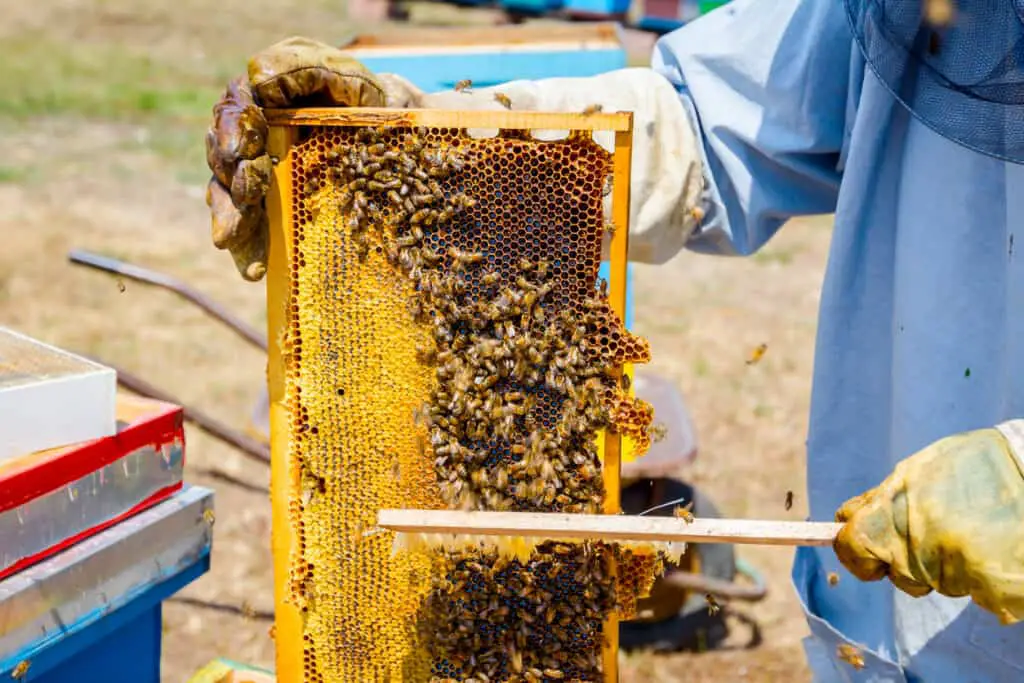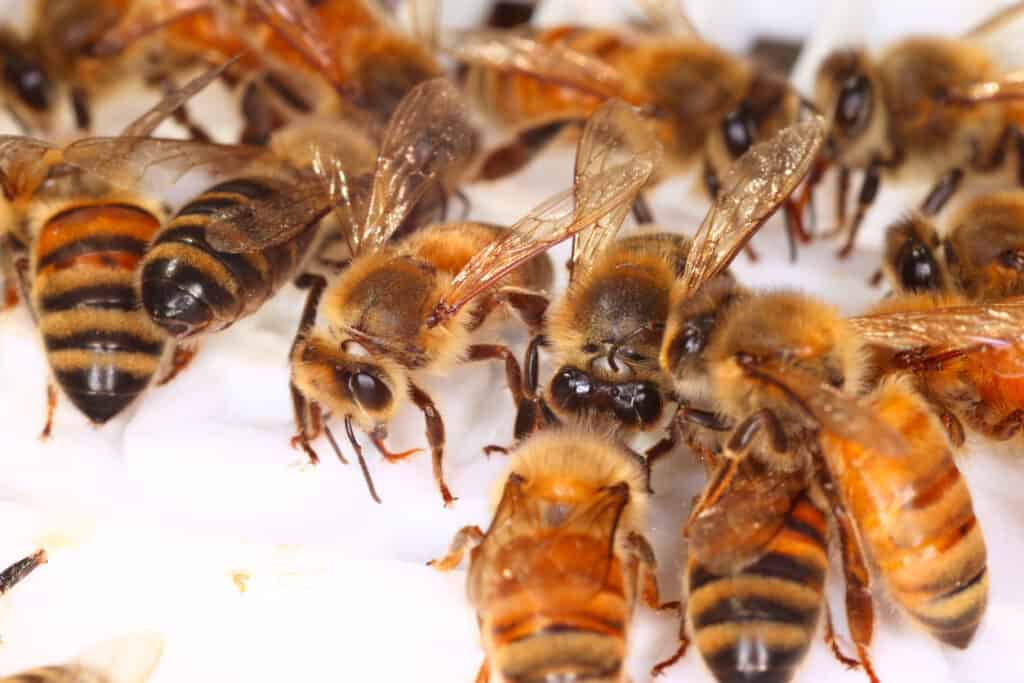The scourge of varroa mites is almost inevitable if you have been a beekeeper for any considerable amount of time. Knowing how to treat this infestation is life, no, bee saving.
Chemical treatments involving formic acids, oxalic acids, and Thymol have higher treatment efficacy. But using less evasive methods like installing screened bottom boards, sprinkling powdered sugar, creating breaks in broods, and even introducing mite-resistant stock should be considered first.
Beekeepers’ techniques to get rid of a varroa mite infestation can generally be categorized into cultural approaches, mechanical, chemical, and natural treatments. A combination of these is what most current literature supports maintaining a higher efficacy with fewer instances of the mites developing resistance against them. This holistic treatment is known as Integrated Pest Management.
What Are The Treatments For Getting Rid Of Varroa Mites?

Varroa destructors are currently some of the most insidious pests infirming honeybees. These mites have a long history in the United States. Beekeepers widely scrutinize them because of their ability to sneakily reproduce in the same cells as the growing worker and drone bees.
The ability of varroa mites to reproduce in capped brood while evading chemical treatments makes it necessary for concerned beekeepers to know other effective treatments. Eradicating the presence of these mites can help keep your entire bee colony healthy by protecting it from the slew of deadly viruses they introduce.
Varroa mite population control helps maintain the metabolism of your bees year-round. Therefore, the careful execution of controlling the mites is so crucial. As a honey farmer, you need to be monitoring the levels of destructors in your colonies to determine if there is a need for treatment and be able to initiate the most appropriate treatment type.
It is generally accepted to measure the average population of mites which is usually the number of mites for every 100 bees. This measurement is often done on a monthly schedule so that the number of mites observed on developed worker bees begins to exceed a set threshold.
Having a low mean abundance affords you the ability not to introduce an aggressive treatment, and you can control the low mite population through cultural and chemical methods. This information is vital to have in mind as we work through each possible treatment that you can then take and tailor to your bee yard needs.
Many treatments that can be easily and quickly implemented are fortunately available in the market:
- Integrated Pest Management (IPM). This approach combines several differing protocols for treating pests. This technique reduces the odds of the pests developing a chemical resistance as could happen if a single treatment is continually reused.
- Medication. This is the most common way that pests were dealt with in the past, but it is now understood as a measure that should be implemented as a last protective resort because this frequent use of a single medication can reduce its effectiveness.
- Natural treatments. With the introduction of IPM, different and effective natural practices for controlling the plague of varroa mites have been given the spotlight once again.
- Plastic strips. This trickier treatment requires beekeepers to use plastic strips injected with chemicals.
- Mechanical control. This is a significant player in the IPM methodology, and it is essential for good reasons. This approach only involves the changes in the management of your beekeeping practices instead of reliance on potentially harmful chemicals.
- Mite Resistant Bees. If pests are a huge issue in your bee colonies, then getting new stock resistant to varroa mites or learning how to help your bees resist this infestation can help.
Integrated Pest Management For Higher Treatment Efficacy

The IPM practice has different levels that incorporate some treatments along the pest control spectrum. This unified approach utilizes long-term pest and damage prevention strategies as its goal.
This holistic management focuses on cultivating a healthier attitude in identifying, observing, and dealing with pest issues before treatments. This creates an environment that allows for a more natural population life.
Cultural Approach For A More Natural Varroa Mite Treatment
This type of approach is mostly tailored toward decreasing the reproduction rate of pests. Buying mite-resistant honey bee stock, availing of small cell comb, and providing a brood break is all cultural control for preventing and controlling a varroa mite infestation.
Purchasing Stock With Resistance
Bees with mite resistance can help limit chemical resistance for varroa mite population control. Several different stocks with this resistance have been developed and bred. European honey bees have had the most prolonged contact with ectoparasitic mites, while American bees have been plagued by these only since 1987.
1. Russian Bees
Russian bees can suppress varroa mites from reproducing more than other bees. This ability slows the increase of the population of mites by impeding mite reproduction. This phenomenon can be observed through reduced infestation of broods and cells.
Other bees inoculated using the mite-vectored deformed wing virus displayed stunted viral replication.
2. Varroa Sensitive And Hygienic Bees
These bees, sensitive to varroa mites, can quickly identify and eliminate eggs that have mite infection. This also helps them recognize and clean out dead brood much quicker than other bees, making them hygienic. This removal skill possibly makes them better at ridding beehives of mites.
The hygienic and mite-sensitive bees can tell that the mites are not only present in the hive but are also intrusive entities.
3. Biting Bees
This brood type is also known as leg chewers or ankle bites because of their mite-biting ability. This characteristic of injuring and killing the mites can be seen through the pests that have died and fallen past the screen and onto a sticky board.
You can use these dead mites to work out the proportion that the bees have killed to see if the colony has this ability and has it to what degree of potency.
Besides importing bees from Europe that have cultivated a mite resistance, you can utilize a smaller cell comb.
Implement Smaller-Sized Cell Combs

Due to industrialization and modernization, the size of the hexagon cells has been manufactured more significantly to produce more giant bees capable of creating more honey. This larger-sized commercial foundation is in opposition to what you observe in nature.
Wild bees tend to have combs built from hexagonal cells that are smaller in size. These small cells are said to have a proportional mite population size. This decrease in mite reproduction in the cells results from a shorter post-capping period.
Although the efficacy of this method is still debated, it is not harmful to the bees to still implement it.
Create A Break In The Brood Cycle
Facilitating a break in the brood involves removing or caging the queen bee for around three weeks. At the same time, the queen is out; the entire brood hatches and forces the infestation out towards the adult bees. Adult bees increase their grooming behavior when there is no brood, and this helpful trait can be made more potent by combing it with a screened bottom board.
This process can have tremendous effects on available space for the varroa mite to reproduce. The potency of this technique increases if the brood break is time correctly and could potentially relieve the bees of stress and provide the colony with a young queen for the winter season.
The positive thing about using this method is that it can be pretty effective in stomping out mite reproduction, but it can negatively affect the colony and slow honey production.
Combining this method with some chemical treatment can significantly impact the population of varroa mites in your bee yard.
Mechanical Approach As A Chemical-free Varroa Mite Treatment
Mechanically manipulating the colony can be a powerful alternative for effectively controlling varroa mites. Stacking a number of these mechanical techniques increases their potency.
Trapping The Varroa Mites
This process uses the mites’ preferences for drone brood for reproducing. Using the drone brood as a trap and removing them works wonders. You can add a drone comb to a colony to encourage drone production, which you can then use as a trap for the mites.
Simply removing the trap comb before the drone can emerge successfully removes the mites from reproducing in the cells. You can then freeze the drone brood or scrape it off the frame and return it to the colony.
Trapping the mites does reduce their reproduction and lengthens the time they take to reach the population threshold. However, it is adequately effective in controlling varroa mites when used with the other treatments.
You can clear out many mites using this method, but it does take the colony much energy to raise a frame’s worth of drones. This steals resources that you could use to raise younger bees, draw out wax or produce honey.
The procedure could also backfire if you forget to remove the frame of drones because you will have an environment ripe for mite breeding.
Use Screened Bottom Boards
The bees’ natural movement and grooming cause mites to drop out of the colony themselves. These mites fall onto the solid wood at the bottom and can climb back up. Replacing this solid wooden board with a screened bottom board reduces the likelihood of returning pests and lowers the number of mites found in the brood.
This method is excellent because it doesn’t disrupt the daily life of the bees but does fail to remove a lot more mites than other methods that you could be doing. It can also affect brood breeding during cold seasons because you have inevitably created the window.
Again, like all the techniques used in pest management, the screen bottom board should be part of an overall control regime incorporating various of these methods.
Sprinkle Powdered Sugar On The Bees
Applying powdered sugar stimulates the bees grooming behavior, making this an ideal method for mite control. Beekeepers end up with more mites being collected on the bottom boards due to the efficacy of this process, but this process increases labor.
It is helpful to know that this technique can be used on bees that have been removed from the hive equipment. Unfortunately, this method can also be quite labor-intensive, but it does go quite well with the screened bottom board technique.
You could also sprinkle any other safe form of dust (talc, for example), as this method can be described as the fine dust method. It inhibits the piggybacking nature of matured mites as it covers adult bees with inert dust particles, which causes the mites to lose their grip.
Chemical Approach For Some Expedient Varroa Mite Treatment
Varroa mites rapidly reproduce during summer and spring, leading to a population boom in the fall. Bee farmers often use chemical miticides to control this spread over winter if the economic threshold has been breached.
The Integrated Pest Management system leans more into using soft chemicals whenever their application is feasible.
Use Soft Chemicals
Chemicals derived naturally are considered soft chemicals. These chemicals are preferred over complex chemicals because they don’t leave a waxy chemical residue in the hive products. These soft chemicals include organic acids, hop beta acids, and essential oils.
Use Mite-Away II (Formic acid)
This chemical naturally occurs in the honey bee venom and is a part of honey. When used at high concentrations and temperatures between 55 to 85 degrees Fahrenheit, it can penetrate the wax capping and kill the mites.
Formic acid can come as Mite Away Quick Strips and is applied over the wax pad, but it also does come available in gel packs but is acidic and challenging to administer.
Use Oxalic acid
Plants produce this compound. You can use the chemical as a home mix vapor or dribble formulation to kill off the mites. It fails to penetrate past the wax capping and is ideal for being used during periods without broods.
Use Apiguard (Thymol)
This essential oil chemical has been formulated from the thyme plant. It also fails to penetrate the cell capping to the mites reproducing in broods and is primarily helpful in controlling mites on adult bees. This treatment is environment-dependent, with efficacy varying according to the colony’s strength and the environmental conditions.
Apiguard comes packaged as slow-releasing gel matrices, which aid in getting an effective dosage of the thymol active ingredient. This treatment is easier to implement and safer than caustic formic acid.
Use Hops Beta Acids
This chemical is formulated from the hops plant, and the potassium salts are safe to be used even during the honey flow. It is most effective when there is less brood to contend with, as it cannot penetrate the cell capping. Although efficacy is not as high as that of the other soft chemicals, it is not environmentally or temperature-dependent but does require multiple applications on broods.
Hard chemicals
Synthetic acaricides or miticides seem to be some of the most potent chemical treatments. These synthetic chemicals can clear out 95 % of the mite population.
The most popular of these is Amitraz. In its original form, the acaricide does exist as a honey or wax contaminant. Unfortunately, there are variations of metabolites that do naturally persist as contaminates, which could be linked to viruses that increase the brood mortality rate.
Similar to some miticides that were most commonly used in the past, such as fluvalinate and coumaphos, Amitraz has some resistance.
Medicating For Eradicating Varroa Mites
For the majority of beekeepers that aren’t practicing the IPM method, using chemicals to kill mites is the only tried and tested avenue. Once you notice the beginning stages of a mite infestation, promptly begin treating any bee colony using the directions on the effective miticides of your choosing.
It is wise to alternate between a number of these to avoid giving the mites time to develop resistance. You should also not use any medication treatment on the bees if there are honey supers. Treatment would contaminate the honey and make it toxic to humans. Although, bees will still be able to consume the honey without any health issues.
1. Use Packaged Apistan
Apistan or fluvalinate comes in chemically-imbued strips. You should hang two of these strips in your chosen brood chamber to be positioned close to the brood. You want the bees to come into contact with the strips by themselves. Close contact between the bees is what spreads the miticide.
2. Use CheckMite+
Because of Fluvalinate tolerance, CheckMite+ has been one of the many newly developed miticides. It is also manufactured, packaged, and presented almost the same way to Apistan. However, it is trickier to use safely and is catered only to experienced beekeepers.
Utilizing Natural Means To Combat Varroa Mites
Chemicals are not always the ideal route in treating pests because of all the dangers and health risks their ease of access and use inherently come with. On top of dusting the beehive with powdered sugar, using screened bottom boards, and introducing mite-resistant bees.
Use Natural Herbs And Plants
The active soft chemical ingredient Thymol is extracted from the thyme plant. Thus, there can be benefits in using thyme to deter pests. Planting thyme and other essential oil plants around your hive could be a pleasant and aesthetic cure for pest-induced headaches.
Mechanical Control Mite-Control Tactics
As we have already learned from the IPM section, mechanical control methods can be very effective when implemented alongside a few other varroa mite control practices.
The main mechanical control methods are:
- Screened bottom boards.
- Drone-brooding trapping.
- Inert dust or the powdered sugar method.
- Introducing mite-tolerant stocks.
- Practice hygienic behavior. This reduces the likelihood of varroa parasitism through breeding bees that show traits that tend towards colony hygiene.
- Introduce Varroa Sensitive Hygiene stock. These are the bees that are created to detect and remove varroa mites.
- Split the bee colonies. This works by reducing the number of possible hosts for the varroa mites and reducing the number of mites. Dividing the colonies into smaller colonies with their queen makes it possible to raise more bees overall.
Selectively Using Mite-resistant Stock For Pest Control
Using bees, like Russian bees, has been proven to be a very effective method of combating pest infestation. Importing European bee stock is advisable if you don’t wish to pour in more human resources or resort to bio-weaponry in your bee colonies.
The Russian strains of bees are over twice as resistant to mites compared to other commercial bee stocks.
How To Monitor The Proliferation Of Varroa Mites
Before deciding on what treatment to use in your colony to fight the scourge of mites, it is essential to know to what degree the intervention is required. The first step toward any treatment regime is knowing the mite population in your beehives.
Proper inspection is required because many beekeepers often miss varroa mites during regular beehive inspections until a noticeable population boom is noticed.
Mites prefer drone brood and can mostly be found by checking sealed drone cells. It would help if you split the separate hive boxes to open drone cells for inspection because bees usually build their drone combs in between the boxes.
Look through the white pupae and pay attention to any coppery brown mites.
Immediate steps should be taken if there is an infection. Spotting and acting on infection in its early stages often reduces the work required if you only spot them later.
Use The Sticky Board Method
This is one of the most sensitive methods for sampling the varroa mite population. You can buy a commercial sticky board that comes as a pre-applied adhesive and sampling illustrated on the surface.
However, some beehive boxes have their screened bottom boards with a plastic sheet that can be sprayed with vegetable oil and inserted into them. You can also make your sticky board from wooden frames with an attached screen. Once constructed, you can put contact paper at the base and spray it with vegetable oil.
This sheet prevents the bees from cleaning away the mites. You leave the sticky board for 24 hours and come back to count the number of varroa mites on it. Depending on the size of your colony, if the number is between 60 and 190 mites, then treatment measures might need to be taken.
Use The Alcohol Wash Method
To properly use this technique, you need to pour an inch or two of rubbing alcohol into a 1-pint clear container that can be closed.
You then shake or gently brush about 200 adult bees into the container and then count the number of mites you may find on them, as the mites do like to hitchhike on adult bees to move around. This batch of bees should be from a frame with a developing brood because mites hitchhike to find broods.
To find the mites, you need to put in some elbow grease, shake the container thoroughly for about half a minute and note the number of mites that are either dead or alive at the bottom. Commence with treatment if you find ten or more mites per 200 bees. This method isn’t too great because you will probably lose those honey soldiers.
Use The Powdered Sugar Shake Method
You use this technique to check the approximate percentage of adult bees carrying mites without having to massacre the bees. You use a jar with a screened lid and fill it with 300 sugar-coated bees.
Once the prep is done, you let the container sit for a few minutes and shake it over a white surface. Once you have gotten all the mites you can from the shaking, you then spray the mites with water to make counting them easier. Do at least three samples for a more scientific estimation.
As the mite population threshold varies per season, you may want first to find out the correct threshold for your colony. If the percentage of mites you get from this method exceeds it, you may also want to begin treatment.
Conclusion
With all of these pest therapies available, you no longer have to worry about having ruined beehives and developing split ends over worries of losing stock. Combining these therapies appears to be the all-around best and most effective route.
Integrated Pest Management is beneficial for stocks susceptible to these pest invasions to having a nuclear situation around the bee yard. Combing several different mechanical and cultural therapies can take away the dread of maintaining healthy stock.

